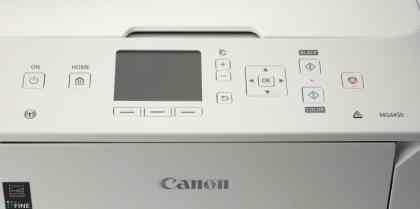Canon's new Pixma MG6450 is a mid-range multifunction peripheral (MFP) with a bias towards creative home use. It replaces the MG6350, with the most obvious difference being that this model is slightly cheaper and is available in black, white or a strange metallic plum colour.
Like its predecessor, this MFP does without a fax modem or automatic document feeder, but there is support for wireless networks. Set up Wi-Fi networking, and you'll be able to take advantage of Canon's support for Google Cloud Print, Apple AirPrint, network printing from the company's own mobile apps on Android or iOS, and printing by sending content to the printer's unique email address. Further direct printing and scanning options take advantage of the all-in-one's built-in memory card slot and 7.5cm colour screen.

The Pixma range has always been stylish, but it feels like the good looks of the MG6450 come at the expense of practicality. Access to the print heads and ink cartridges is through a narrow slot accessed by lifting up the entire control panel section; it's neat, but there's limited access so it can be hard to get cartridges lined up properly at the rear. While we had the same criticism of the outgoing MG6350, we liked that model's practical touchscreen system. For the MG6450, Canon has fitted a screen and directional button controls. This is a little less elegant and intuitive than the previous model's touchscreen, but it's reasonably functional, if occasionally inconsistent.

Unfortunately, there are worse problems when it comes to this MFP's paper handling. While there's still automatic duplex (double-sided) printing, there's now only a single paper tray that appears to be captive in the base of the printer. The front panel has to be kept open when it's loaded with A4 paper, which could allow dust onto the stack over time. This problem is common to several of Canon's lower-end Pixma models, but at £100, we expected the MG6350 to have better paper handling.
During our first print test the output tray didn't seem able to contain A4 paper, allowing printed sheets to teeter over its edge like the bus in the Italian Job. Only after further examination did we uncover a paper stay concealed in the forward edge of the input tray, which extends to form a stop for printed pages over-running the output tray above. It's a similar system to that used on several cheaper Pixmas, but while it works reasonably well it again seems rather basic at this price.
